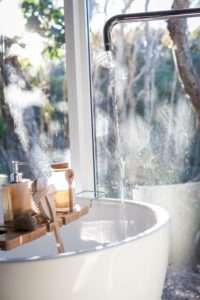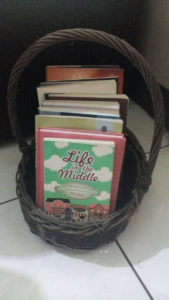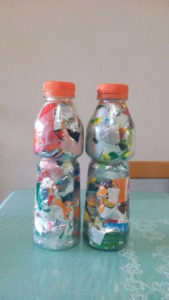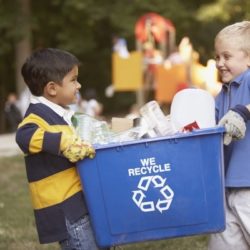Photo by Jakub Jacobsky on Unsplash
An eco-friendly home is a dwelling place that is not harmful to the environment, or at least minimizes its bad effects on the surroundings.
If you’re planning to construct a new house or choosing a condominium, consider a structure that implements eco-friendly or “green” building practices, such as installing energy-efficient solar panels, windows and doors, using sustainable materials like recycled glass and steel, and installing water-efficient faucets and flush mechanisms.
But even if you are not building a new abode, your family can take simple, practical steps and develop habits that can reduce damaging effects on our planet. By consciously thinking of ways to minimize the use of electricity and water, reducing solid wastes (especially plastic) and all forms of pollution, and decreasing carbon emission, we can have an eco-friendly home. Here are some tips to help you do that:

Ensure that water is used wisely. Fix any leaks. Don’t let water flow from the tap continuously while brushing your teeth, shaving, or washing your face. Instead, use a glass or basin of water to help you complete your routine. Using a pail and dipper (tabo) in bathing consumes less water than using the shower.
Compost food scraps. Composting reduces the amount of food waste that goes into the landfill. Wastes in landfills may cause harm to underground water when it rains. Our former neighbor made compost by throwing vegetable or fruit peels, eggshells, and dry leaves into a large, deep plastic drum filled with soil and covered. The compost was then used as fertilizer for her plants. (For detailed instruction on composting, download this primer from the Bureau of Soils and Water Management.)
Oversee your electricity consumption. Turn off lights and unplug electrical appliances when not in use. Set your computer to sleep mode when you need to be away from it for some minutes or hours to preserve energy. Switch to energy-efficient appliances (e.g. inverter type air conditioner). Compact fluorescents and LED bulbs are brighter and last longer than incandescent bulbs.
Clean air conditioners and electric fans to keep them working efficiently and help lower your expenses on electricity. Meralco has introduced its prepaid electricity service, Kuryete Load, that can help you monitor your electricity spending via text and pay your consumption by loading your registered account. Visit your nearest Meralco Business Center for details.
Find environment-friendly products and alternatives. With more individuals and business enterprises becoming conscious of protecting the environment, we now have more eco-friendly options. Our family now uses a known brand of detergents and personal hygiene products that are natural, biodegradable, and made from renewable resources. You can also use items from your kitchen to clean your house and for beauty treatments. Baking soda and vinegar are good alternatives to commercial toilet cleaners. I’ve used homemade beauty treatments like coffee body scrub, honey and olive oil facial mask, and virgin coconut oil for shinier hair.
Reuse, reduce, recycle, repurpose. These 4Rs are your keys to making your home eco-friendly and budget-friendly. At home, we reuse water from the washing machine to clean the bathroom. I only buy personal items that I have use for, or delay buying items until I need a replacement. Old garments and towels are recycled as rags. Wicker baskets used to package Christmas goodies are repurposed as book baskets.
Intentionally plan your meals to avoid food wastes. Leftover foods can be one of the biggest wastes at home. Take note of your family’s eating habits and plan your meals accordingly. Train younger children to take only as much as they can eat. If your spouse or adult children come home at irregular hours or have dinner appointments, ask them to inform you ahead so that you can prepare just enough food for family members eating at home.

Endeavor to reach a zero plastic waste lifestyle, or at least live with less of it. Many local governments have already passed ordinances prohibiting the use of plastic bags. But plastic containers and product packaging are still everywhere—from plastic water bottles, shampoo and condiment sachets to chips and cookie wrappers. Try making ecobricks to dispose these plastics in a productive and eco-friendly way. Ecobricks are an innovative solution to pollution because it keeps plastic and carbon dioxide out of the biosphere. Plastics are packed densely in plastic bottles then used as building blocks for walls and benches. Learn how to make ecobricks and donate them to groups like Ecobricks Philippines. See how one hostel turned ecobricks into shower stalls in this website.

Never hoard. Hoarding deprives others the opportunity to purchase things that they also need like rice, food, and household supplies. Take stock of what your family truly needs within a specific period of time and provide for them. Rather than fear that you will run out of an item, be good stewards of your resources and trust God to provide for your family’s every need. Accumulated items are safety hazards and may cause sanitary problems.
Decorate your home with sustainable and renewable materials. Bamboo, salvaged used wood products, and recycled glass can be used to decorate your house. With imagination and patience, you can also make decorative and functional items from nature and discarded materials. My friend Miel makes decorative masks, wall decor, vases, ref magnets, and paper weights from twigs, tree bark, dry leaves, stones, recycled canisters and other junk. (Check out his video tutorial on making rustic ref
Liven up your home space and improve air quality in your rooms by putting house plants. Some plants help purify the air. Locally available indoor plants like pako, spider plant, snake plant, and aloe vera can protect your family from indoor air pollution from aerosol sprays, toilet cleaners, insect repellants, and paints. Take care of your plants and they will take care of you.
Yearly or quarterly, assess what you need to dispose, and dispose them properly. A TV lifestyle program host once said that if you haven’t worn a dress for a year, you probably will not wear it again, so dispose it. It would be good for the environment if we consume moderately and dispose properly. Check your closets for clothes you can give away or sell at a garage sale. Inspect cupboards, refrigerators, and medicine cabinets for expired items. Before throwing the solid contents of canned or bottled goods in a garbage bag, pour all the liquid in the sink and flush them thoroughly. Take extra care when disposing expired medicines. Bring old and defective computers and gadgets to establishments that accept this kind of junk. Avoid surface water and soil contamination through proper waste disposal.
Making your home eco-friendly will result in a clean, pleasant, and organized space. It will help you manage your financial and material resources more effectively and potentially increase your savings. Most of all, it will do the least possible damage to this Earth we live in, increasing the likelihood of us living in a safe and healthy environment. Being responsible for this Earth honors the God who created it and entrusted it to us.

Marlene Legaspi-Munar writes about marriage, family, personal development, and travel. She and her husband Anthony co-authored How to Keep Your Misis Happy, which is a perfect partner to her other book How to Keep Your Hubby Happy. Learn more about her other books from her author page facebook.com/AuthorMarleneLegaspiMunar.
Related Posts
-
Family Friendly Weekend Flicks
Get the popcorn ready and enjoy these amazing movies with the family this weekend!
-
Earth-Friendly Habits to Practice at Home
One of the most precious gifts parents can give to their children is to ensure…
-
Becoming a Better Leader at Home
A man's responsibility is to be a better leader in his own household, one that…




Heya! I’m at work browsing your blog! Just wanted to say I love reading your blog and look forward to all your posts! Keep up the outstanding work!